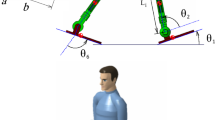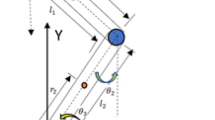Abstract
The parametric variations and external perturbations in the coupled subject-exoskeleton system delay and hinder effective gait tracking in clinical rehabilitation. This problem becomes more challenging in the case of the pediatric exoskeleton system. In this work, to address this benchmark challenge, a fast terminal sliding mode with a rapid reaching law (FTSM-RRL) control scheme is introduced for an uncertain lower-extremity exoskeleton aimed at assisting pediatric gait under different walking speeds. At first, the computer-aided design of the gait exoskeleton system is demonstrated with details of the desired gait trajectories of a male boy aged 12 years (weight: 40 kg, height: 132 cm). A fast terminal sliding mode controller is proposed with a varied exponential approaching rule to guarantee the rapid convergence of system states on the sliding manifold and then towards the origin in a finite period. After that, an upper limit criterion is involved within the reaching control law to compensate for the adverse effects of uncertainties and disturbances as a lumped parameter. Lyapunov’s theory is presented to ensure the expeditious convergence of the tracking error in the reaching and sliding phases. The proposed FTSM-RRL strategy is incorporated to obtain the desired trajectory tracking at slow, self-selected, and fast walking speeds. From numerical experiments, the proposed FTSM-RRL controller is found to be consistently effective (\(> 71\%\) in X-direction and \(> 62\%\) in Y-direction) over the PID controller and (\(> 7\%\) in X-direction and \(> 10\%\) in Y-direction) over the FTSM-ERL controller. In joint space, the proposed FTSM-RRL control consistently surpasses both PID and FTSM-ERL controls in tracking hip movement. While the proposed controller outperforms PID and FTSM-ERL for knee joint tracking, the extent of improvement diminishes at higher speeds. For ankle joint tracking, the proposed control exhibits substantial enhancement at slow speeds but comparatively poorer performance at self-selected and fast speeds when compared to PID control. However, FTSM-RRL consistently outperforms FTSM-ERL across all speeds for ankle joint tracking. Compared to FTSM-ERL control, the proposed FTSM-RRL control accelerates the hip and knee joint sliding surface convergence by 0.52s and 0.24s (slow walking), 0.55s and 0.33s (self-selected walking), and 0.61s and 0.09s (fast walking). The results obtained in this study ensure fast and efficient passive-assist gait training for the pediatric groups using exoskeleton technology.



















Similar content being viewed by others
Availability of data and materials
This is not applicable since no datasets were generated and stored during the study.
References
Aljuboury, A.S., Hameed, A.H., Ajel, A.R., Humaidi, A.J., Alkhayyat, A., Mhdawi, A.K.A.: Robust adaptive control of knee exoskeleton-assistant system based on nonlinear disturbance observer. Actuators 11, 78 (2022)
Andrade, R.M., Sapienza, S., Bonato, P.: Development of a “transparent operation mode” for a lower-limb exoskeleton designed for children with cerebral palsy. In: 2019 IEEE 16th International Conference on Rehabilitation Robotics (ICORR), pp. 512–517. IEEE (2019)
Baud, R., Manzoori, A.R., Ijspeert, A., Bouri, M.: Review of control strategies for lower-limb exoskeletons to assist gait. J. Neuroeng. Rehabil. 18(1), 1–34 (2021)
Booth, A.T., Buizer, A.I., Meyns, P., Oude Lansink, I.L., Steenbrink, F., Krogt, M.M.: The efficacy of functional gait training in children and young adults with cerebral palsy: a systematic review and meta-analysis. Dev. Med. Child Neurol. 60(9), 866–883 (2018)
Borase, R.P., Maghade, D., Sondkar, S., Pawar, S.: A review of pid control, tuning methods and applications. Int. J. Dyn. Control 9, 818–827 (2021)
Brahmi, B., Driscoll, M., Laraki, M.H., Brahmi, A.: Adaptive high-order sliding mode control based on quasi-time delay estimation for uncertain robot manipulator. Control Theory Technol. 18, 279–292 (2020)
Bumbard, K.B., Herrington, H., Goh, C.-H., Ibrahim, A.: Incorporation of torsion springs in a knee exoskeleton for stance phase correction of crouch gait. Appl. Sci. 12(14), 7034 (2022)
Chen, C.-F., Du, Z.-J., He, L., Wang, J.-Q., Wu, D.-M., Dong, W.: Active disturbance rejection with fast terminal sliding mode control for a lower limb exoskeleton in swing phase. IEEE Access 7, 72343–72357 (2019)
Chen, J., Hochstein, J., Kim, C., Tucker, L., Hammel, L.E., Damiano, D.L., Bulea, T.C.: A pediatric knee exoskeleton with real-time adaptive control for overground walking in ambulatory individuals with cerebral palsy. Front. Robot. AI 8, 702137 (2021)
Cumplido-Trasmonte, C., Ramos-Rojas, J., Delgado-Castillejo, E., Garcés-Castellote, E., Puyuelo-Quintana, G., Destarac-Eguizabal, M., Barquín-Santos, E., Plaza-Flores, A., Hernández-Melero, M., Gutiérrez-Ayala, A.: Effects of atlas 2030 gait exoskeleton on strength and range of motion in children with spinal muscular atrophy II: a case series. J. Neuroeng. Rehabil. 19(1), 1–10 (2022)
Feraru, L.M., Solomon, M.E.: Gradual correction of pediatric equinus deformity. Clin. Podiatr. Med. Surg. 39(1), 143–156 (2022)
Fricke, S.S., Bayón, C., Kooij, H.V., Asseldonk, E.H.: Automatic versus manual tuning of robot-assisted gait training in people with neurological disorders. J. Neuroeng. Rehabil. 17(1), 1–15 (2020)
Hasan, S., Dhingra, A.K.: Development of a sliding mode controller with chattering suppressor for human lower extremity exoskeleton robot. Results Control Optim. 7, 100123 (2022)
Hernández, J.H., Cruz, S.S., López-Gutiérrez, R., González-Mendoza, A., Lozano, R.: Robust nonsingular fast terminal sliding-mode control for sit-to-stand task using a mobile lower limb exoskeleton. Control. Eng. Pract. 101, 104496 (2020)
Jenhani, S., Gritli, H.: Lmi-based design of an affine pd controller for the robust stabilization of the knee joint of a lower-limb rehabilitation exoskeleton. In: 2023 IEEE International Conference on Advanced Systems and Emergent Technologies (IC_ASET), pp. 1–7. IEEE (2023)
Kang, Z., Yu, H., Li, C.: Variable-parameter double-power reaching law sliding mode control method. Automatika 61(3), 345–351 (2020)
Khamar, M., Edrisi, M.: Designing a backstepping sliding mode controller for an assistant human knee exoskeleton based on nonlinear disturbance observer. Mechatronics 54, 121–132 (2018)
Kupferman, J.C., Zafeiriou, D.I., Lande, M.B., Kirkham, F.J., Pavlakis, S.G.: Stroke and hypertension in children and adolescents. J. Child Neurol. 32(4), 408–417 (2017)
Lorenzo, T.M., Lara, S.L., Bayón, C., Ramírez, O., Rocon, E.: The cp walker for strength training in children with spastic cerebral palsy: a training program proposal. In: Converging Clinical and Engineering Research on Neurorehabilitation II: Proceedings of the 3rd International Conference on NeuroRehabilitation (ICNR2016), October 18-21, 2016, Segovia, Spain, pp. 1211–1215. Springer (2017)
Narayan, J., Dwivedy, S.K.: Biomechanical study and prediction of lower extremity joint movements using Bayesian regularization-based backpropagation neural network. J. Comput. Inf. Sci. Eng. 22(1), 014503 (2022)
Narayan, J., Kumar Dwivedy, S.: Preliminary design and development of a low-cost lower-limb exoskeleton system for paediatric rehabilitation. Proc. Inst. Mech. Eng. 235(5), 530–545 (2021)
Narayan, J., Bhoir, A.A., Borgohain, A., Dwivedy, S.K.: Design and analysis of a stand-aided lower-limb exoskeleton system for pediatric rehabilitation. In: 2021 International Conference on Computational Performance Evaluation (ComPE), pp. 950–955. IEEE (2021)
Narayan, J., Abbas, M., Dwivedy, S.K.: Robust adaptive backstepping control for a lower-limb exoskeleton system with model uncertainties and external disturbances. Automatika 64(1), 145–161 (2023)
Narayan, J., Auepanwiriyakul, C., Jhunjhunwala, S., Abbas, M., Dwivedy, S.K.: Hierarchical classification of subject-cooperative control strategies for lower limb exoskeletons in gait rehabilitation: a systematic review. Machines 11(7), 764 (2023)
Orekhov, G., Fang, Y., Luque, J., Lerner, Z.F.: Ankle exoskeleton assistance can improve over-ground walking economy in individuals with cerebral palsy. IEEE Trans. Neural Syst. Rehabil. Eng. 28(2), 461–467 (2020)
Sancho-Pérez, J., Pérez, M., García, E., Sanz-Merodio, D., Plaza, A., Cestari, M.: Mechanical description of atlas 2020, a 10-dof paediatric exoskeleton. In: Advances in cooperative robotics, pp. 814–822. World Scientific, Cham (2017)
Sarajchi, M., Al-Hares, M.K., Sirlantzis, K.: Wearable lower-limb exoskeleton for children with cerebral palsy: a systematic review of mechanical design, actuation type, control strategy, and clinical evaluation. IEEE Trans. Neural Syst. Rehabil. Eng. 29, 2695–2720 (2021)
Shi, D., Zhang, W., Zhang, W., Ding, X.: A review on lower limb rehabilitation exoskeleton robots. Chin. J. Mech. Eng. 32(1), 1–11 (2019)
Smania, N., Bonetti, P., Gandolfi, M., Cosentino, A., Waldner, A., Hesse, S., Werner, C., Bisoffi, G., Geroin, C., Munari, D.: Improved gait after repetitive locomotor training in children with cerebral palsy. Am. J. Phys. Med. Rehabil. 90(2), 137–149 (2011)
Sousa, D.G., Harvey, L.A., Dorsch, S., Glinsky, J.V.: Interventions involving repetitive practice improve strength after stroke: a systematic review. J. Physiother. 64(4), 210–221 (2018)
Sun, Y., Tang, Y., Zheng, J., Dong, D., Chen, X., Bai, L.: From sensing to control of lower limb exoskeleton: a systematic review. Annu. Rev. Control. 53, 83–96 (2022)
Tole, G., Raymond, M.J., Williams, G., Clark, R.A., Holland, A.E.: Strength training to improve walking after stroke: how physiotherapist, patient and workplace factors influence exercise prescription. Physiother. Theory Pract. 38(9), 1198–1206 (2022)
Torabi, M., Sharifi, M., Vossoughi, G.: Robust adaptive sliding mode admittance control of exoskeleton rehabilitation robots. Scientia Iranica 25(5), 2628–2642 (2018)
Wang, J., Liu, J., Zhang, G., Guo, S.: Periodic event-triggered sliding mode control for lower limb exoskeleton based on human–robot cooperation. ISA Trans. 123, 87–97 (2022)
WHO: World report on disability 2011. World Health Organization (2011)
Wu, J., Gao, J., Song, R., Li, R., Li, Y., Jiang, L.: The design and control of a 3dof lower limb rehabilitation robot. Mechatronics 33, 13–22 (2016)
Yamada, T., Kadone, H., Shimizu, Y., Suzuki, K.: An exoskeleton brake unit for children with crouch gait supporting the knee joint during stance. In: 2018 International Symposium on Micro-nanomechatronics and Human Science (MHS), pp. 1–7. IEEE (2018)
Yang, X., She, H., Lu, H., Fukuda, T., Shen, Y.: State of the art: bipedal robots for lower limb rehabilitation. Appl. Sci. 7(11), 1182 (2017)
Yang, S., Han, J., Xia, L., Chen, Y.-H.: An optimal fuzzy-theoretic setting of adaptive robust control design for a lower limb exoskeleton robot system. Mech. Syst. Signal Process. 141, 106706 (2020)
Yu, S., Yu, X., Shirinzadeh, B., Man, Z.: Continuous finite-time control for robotic manipulators with terminal sliding mode. Automatica 41(11), 1957–1964 (2005)
Yu, X., Feng, Y., Man, Z.: Terminal sliding mode control—an overview. IEEE Open J. Ind. Electron. Soc. 2, 36–52 (2020)
Zhang, X., Wang, H., Tian, Y., Peyrodie, L., Wang, X.: Model-free based neural network control with time-delay estimation for lower extremity exoskeleton. Neurocomputing 272, 178–188 (2018)
Zhihong, M., Yu, X.H.: Terminal sliding mode control of mimo linear systems. IEEE Trans. Circ. Syst. I: Fundam. Theory Appl. 44(11), 1065–1070 (1997)
Zhou, Z., Tang, G., Huang, H., Han, L., Xu, R.: Adaptive nonsingular fast terminal sliding mode control for underwater manipulator robotics with asymmetric saturation actuators. Control Theory Technol. 18, 81–91 (2020)
Znegui, W., Gritli, H., Belghith, S.: Stabilization of the passive walking dynamics of the compass-gait biped robot by developing the analytical expression of the controlled poincaré map. Nonlinear Dyn. 101, 1061–1091 (2020)
Acknowledgements
The authors are thankful to DSIR-PRISM, India, for sponsoring the project (DSIR/PRISM/78/2016) under which this study was carried out. Moreover, the authors express their gratitude to the Mechatronics and Robotics Lab at the IIT Guwahati for its research support.
Author information
Authors and Affiliations
Contributions
Conceptualization: JN; Methodology: JN, HG; Formal analysis and investigation: JN, HG; Writing - original draft preparation: JN, HG; Writing - review and editing: JN, HG, SKD; Resources: SKD; Supervision: SKD.
Corresponding author
Ethics declarations
Conflict of interest
The authors have no relevant financial or non-financial interests to disclose.
Additional information
Publisher's Note
Springer Nature remains neutral with regard to jurisdictional claims in published maps and institutional affiliations.
Rights and permissions
Springer Nature or its licensor (e.g. a society or other partner) holds exclusive rights to this article under a publishing agreement with the author(s) or other rightsholder(s); author self-archiving of the accepted manuscript version of this article is solely governed by the terms of such publishing agreement and applicable law.
About this article
Cite this article
Narayan, J., Gritli, H. & Dwivedy, S.K. Fast terminal sliding mode control with rapid reaching law for a pediatric gait exoskeleton system. Int J Intell Robot Appl 8, 76–95 (2024). https://doi.org/10.1007/s41315-023-00314-x
Received:
Accepted:
Published:
Issue Date:
DOI: https://doi.org/10.1007/s41315-023-00314-x




